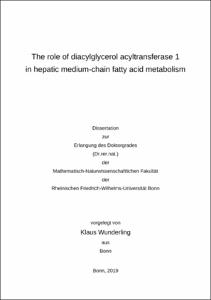Wunderling, Klaus: The role of diacylglycerol acyltransferase 1 in hepatic medium-chain fatty acid metabolism. - Bonn, 2020. - Dissertation, Rheinische Friedrich-Wilhelms-Universität Bonn.
Online-Ausgabe in bonndoc: https://nbn-resolving.org/urn:nbn:de:hbz:5-57299
Online-Ausgabe in bonndoc: https://nbn-resolving.org/urn:nbn:de:hbz:5-57299
@phdthesis{handle:20.500.11811/8273,
urn: https://nbn-resolving.org/urn:nbn:de:hbz:5-57299,
author = {{Klaus Wunderling}},
title = {The role of diacylglycerol acyltransferase 1 in hepatic medium-chain fatty acid metabolism},
school = {Rheinische Friedrich-Wilhelms-Universität Bonn},
year = 2020,
month = jan,
note = {Fatty acids form a class of important biomolecules, serving as essential elements of lipid molecules. Stored in triacylglycerol (TAG), the main constituent of plant oils and animal fats, they from an inseparable part of the daily human diet. Differing carbon chain length and saturation degrees, lead to a great variety of fatty acids in which long-chain-fatty acids (LCFAs) from the major part. The class of medium-chain fatty acids (MCFAs) are mainly found in a variety of plant oils like palm kernel oil and they possess different biochemical and physiochemical properties then LCFAs. Although the cellular metabolism of MCFAs has been object to research for many decades, it is still insufficiently studied in certain details. This thesis connects to previous work in our laboratory where it was proposed that diacylglycerol acyltransferase 2 (DGAT2) plays predominant role in MCFA-TAG synthesis and that cytosolic MCFA-CoAs for TAG synthesis are provided in a carnitine palmitoyltransferase 1 (CPT1)-dependent manner, as treatment with the CPT1 inhibitor Etomoxir reduced MCFA-TAG levels. This present work puts its emphasis on investigating the hepatic metabolism of DGAT-dependent MCFA incorporation into TAG upon treatment with small molecule inhibitors, targeting either DGAT enzymes or mitochondrial CPT1. Freshly isolated primary hepatocytes from wildtype (WT)- or DGAT1-/--mice were treated with inhibitors and pulsed with alkyne fatty acids, followed by lipid extraction and subsequent analysis of the lipid metabolites via thin layer chromatography or mass spectrometry (MS). Here, a novel MS- based methodology to analyze alkyne labeled lipids which was recently developed in our group, was utilized. As observed with the Etomoxir treatment, it was found that a DGAT1 inhibition in WT hepatocytes resulted as well in a MCFA-TAG reduction. Also, a combination of both inhibitors reduced MCFA-TAG levels even further. A DGAT2-inhibition, however, did not alter MCFA-TAG levels. Further, pulse-chase analysis with unlabeled decanoic acid revealed similar effects upon DGAT1 and Etomoxir treatment. Analysis of the lipid profile in DGAT1-/--mice revealed altered MCFA-TAG levels, independent from inhibitory treatment. Interestingly, in DGAT1-/- hepatocytes, Etomoxir-treatment did lead to a similar change in TAG levels as in the WT control. Additionally, in vivo lipopolysaccharide (LPS)- stimulated mice showed overall enhanced lipid levels, but similar responses to the DGAT inhibitor and Etomoxir treatment. Teglicar, another CPT1 inhibitor, did show enhanced TAG synthesis upon treatment. This thesis was concluded by introducing the hypothesis, that hepatic DGAT1 but not DGAT2 is responsible for MCFA incorporation into TAG, which can be compensated partially by DGAT2. It was postulated, that Etomoxir can also act as a potent DGAT inhibitor, predominantly targeting DGAT1, when both DGATs are present. This putative off target effect was not seen with the second CPT1 inhibitor Teglicar.},
url = {https://hdl.handle.net/20.500.11811/8273}
}
urn: https://nbn-resolving.org/urn:nbn:de:hbz:5-57299,
author = {{Klaus Wunderling}},
title = {The role of diacylglycerol acyltransferase 1 in hepatic medium-chain fatty acid metabolism},
school = {Rheinische Friedrich-Wilhelms-Universität Bonn},
year = 2020,
month = jan,
note = {Fatty acids form a class of important biomolecules, serving as essential elements of lipid molecules. Stored in triacylglycerol (TAG), the main constituent of plant oils and animal fats, they from an inseparable part of the daily human diet. Differing carbon chain length and saturation degrees, lead to a great variety of fatty acids in which long-chain-fatty acids (LCFAs) from the major part. The class of medium-chain fatty acids (MCFAs) are mainly found in a variety of plant oils like palm kernel oil and they possess different biochemical and physiochemical properties then LCFAs. Although the cellular metabolism of MCFAs has been object to research for many decades, it is still insufficiently studied in certain details. This thesis connects to previous work in our laboratory where it was proposed that diacylglycerol acyltransferase 2 (DGAT2) plays predominant role in MCFA-TAG synthesis and that cytosolic MCFA-CoAs for TAG synthesis are provided in a carnitine palmitoyltransferase 1 (CPT1)-dependent manner, as treatment with the CPT1 inhibitor Etomoxir reduced MCFA-TAG levels. This present work puts its emphasis on investigating the hepatic metabolism of DGAT-dependent MCFA incorporation into TAG upon treatment with small molecule inhibitors, targeting either DGAT enzymes or mitochondrial CPT1. Freshly isolated primary hepatocytes from wildtype (WT)- or DGAT1-/--mice were treated with inhibitors and pulsed with alkyne fatty acids, followed by lipid extraction and subsequent analysis of the lipid metabolites via thin layer chromatography or mass spectrometry (MS). Here, a novel MS- based methodology to analyze alkyne labeled lipids which was recently developed in our group, was utilized. As observed with the Etomoxir treatment, it was found that a DGAT1 inhibition in WT hepatocytes resulted as well in a MCFA-TAG reduction. Also, a combination of both inhibitors reduced MCFA-TAG levels even further. A DGAT2-inhibition, however, did not alter MCFA-TAG levels. Further, pulse-chase analysis with unlabeled decanoic acid revealed similar effects upon DGAT1 and Etomoxir treatment. Analysis of the lipid profile in DGAT1-/--mice revealed altered MCFA-TAG levels, independent from inhibitory treatment. Interestingly, in DGAT1-/- hepatocytes, Etomoxir-treatment did lead to a similar change in TAG levels as in the WT control. Additionally, in vivo lipopolysaccharide (LPS)- stimulated mice showed overall enhanced lipid levels, but similar responses to the DGAT inhibitor and Etomoxir treatment. Teglicar, another CPT1 inhibitor, did show enhanced TAG synthesis upon treatment. This thesis was concluded by introducing the hypothesis, that hepatic DGAT1 but not DGAT2 is responsible for MCFA incorporation into TAG, which can be compensated partially by DGAT2. It was postulated, that Etomoxir can also act as a potent DGAT inhibitor, predominantly targeting DGAT1, when both DGATs are present. This putative off target effect was not seen with the second CPT1 inhibitor Teglicar.},
url = {https://hdl.handle.net/20.500.11811/8273}
}






